 "HammerheadFistpunch" (hammerheadfistpunch)
"HammerheadFistpunch" (hammerheadfistpunch)
07/23/2014 at 13:35 • Filed to: truck yeah, tech, hhfp
 152
152
 100
100
 "HammerheadFistpunch" (hammerheadfistpunch)
"HammerheadFistpunch" (hammerheadfistpunch)
07/23/2014 at 13:35 • Filed to: truck yeah, tech, hhfp |  152 152
|  100 100 |
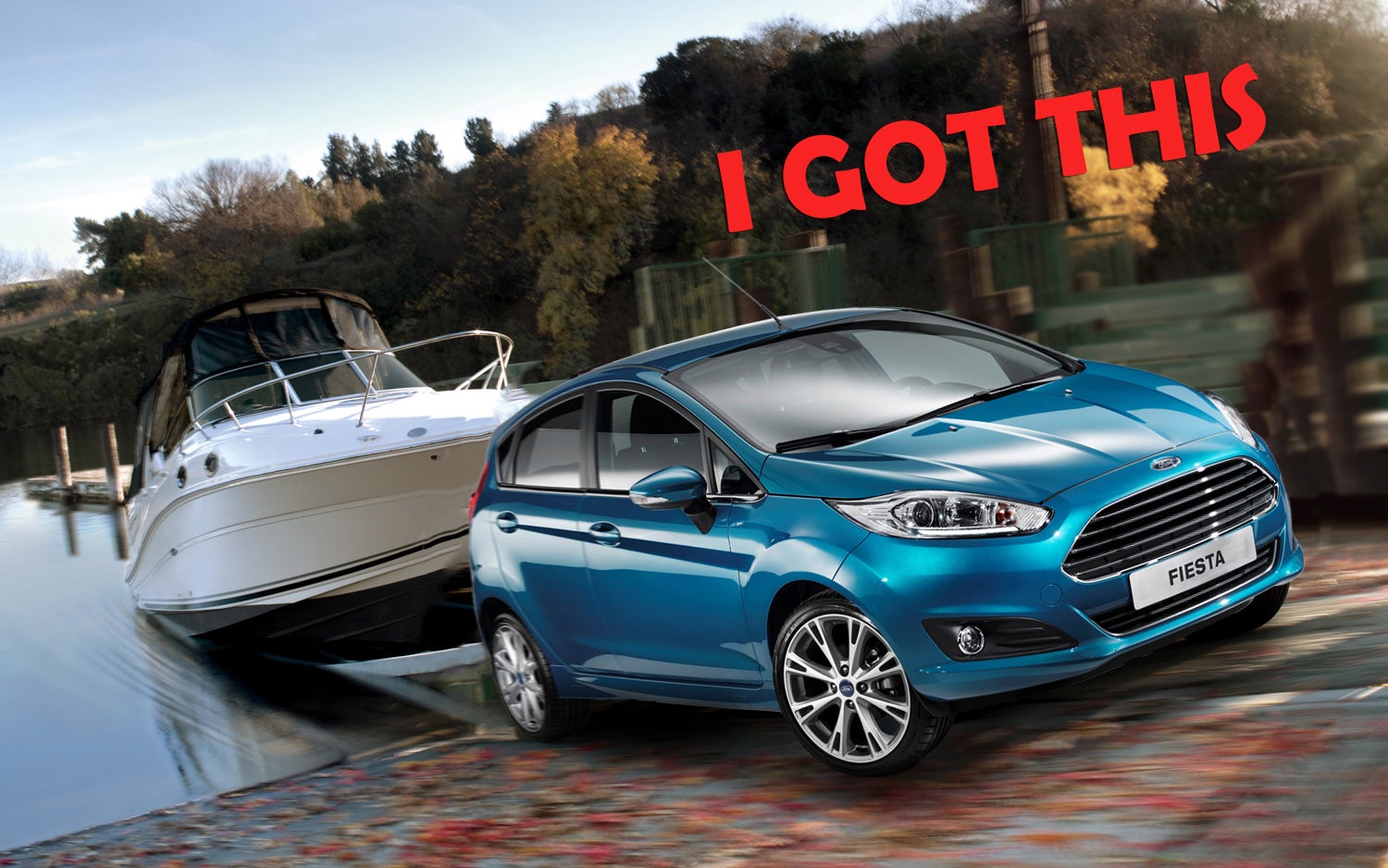
Have you ever wondered out loud and at parties why European countries and other non-American countries seem to be able to tow houses with 1 liter econoboxes where in the US you would need a peterbilt to pull the same load? No? Me too! Wait did you say no? Hey where are you going! I’ve got science!
This question first came to my attention when I owned a forester, a 2005 XT manual to be precise and, having grown up camping and with the addition of a family member started to weigh my options in a towed camping array. Given that the forester is a small car by American standards I wasn’t surprised by the lowish 2400 lb tow rating but upon searching for a light weight travel trailer that my car could handle I stumbled upon several images like this from Australia, the UK and other such places.
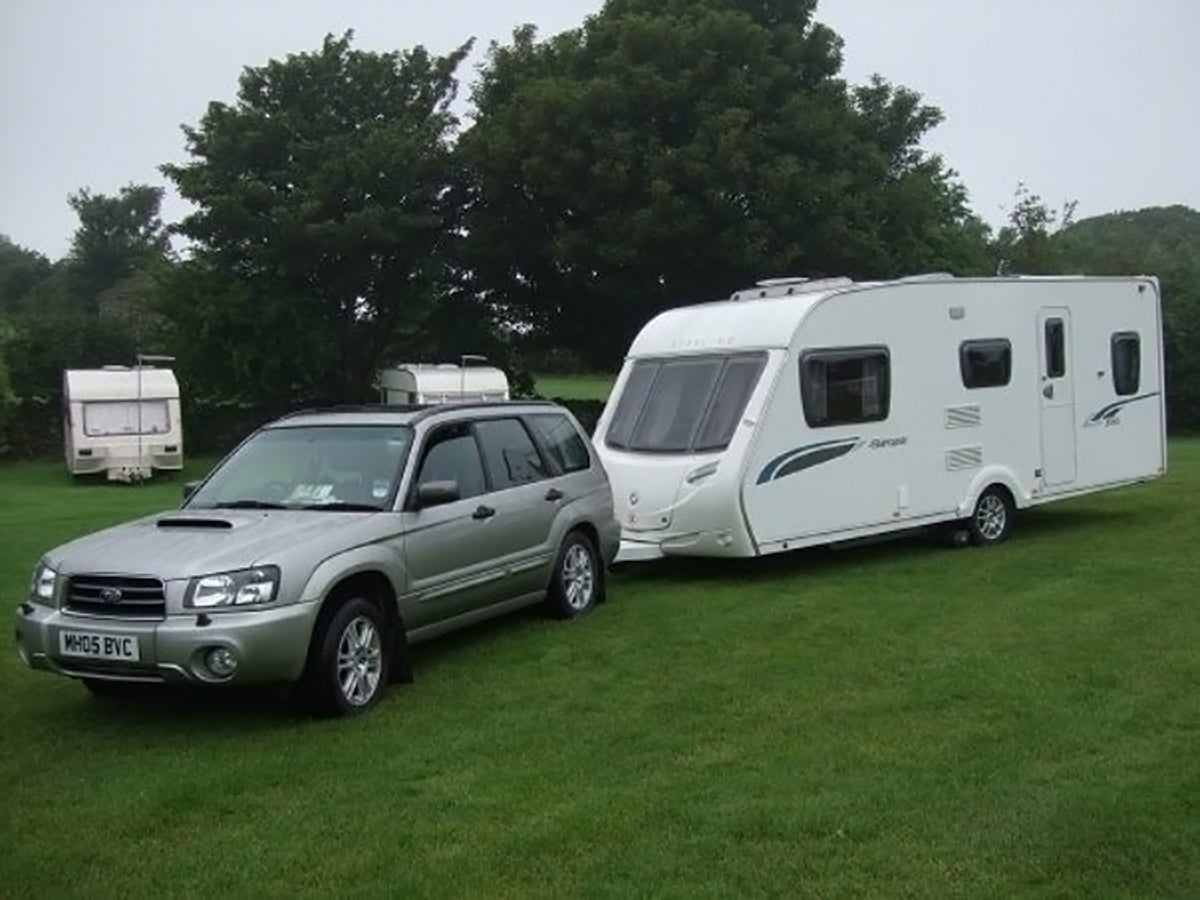
The hell?! That trailer, or “van” as they are called in the land of spiders, HAS to weigh more than 2400 lbs. and I was right. As it turns out in Australia, an SG forester XT...just like mine...is rated to tow 1.8 (braked) tonne or just under 4000 lbs. Well obviously the Aussies have a super tough version that’s different than mine...I mean, everything is tougher in ‘Straya right? Nope, turns out they are, aside from LHD vs RHD, the same exact thing. So what gives? I see this all the time in European countries and as shown by top gear; huge caravans being towed by dinky little things. How is it possible!
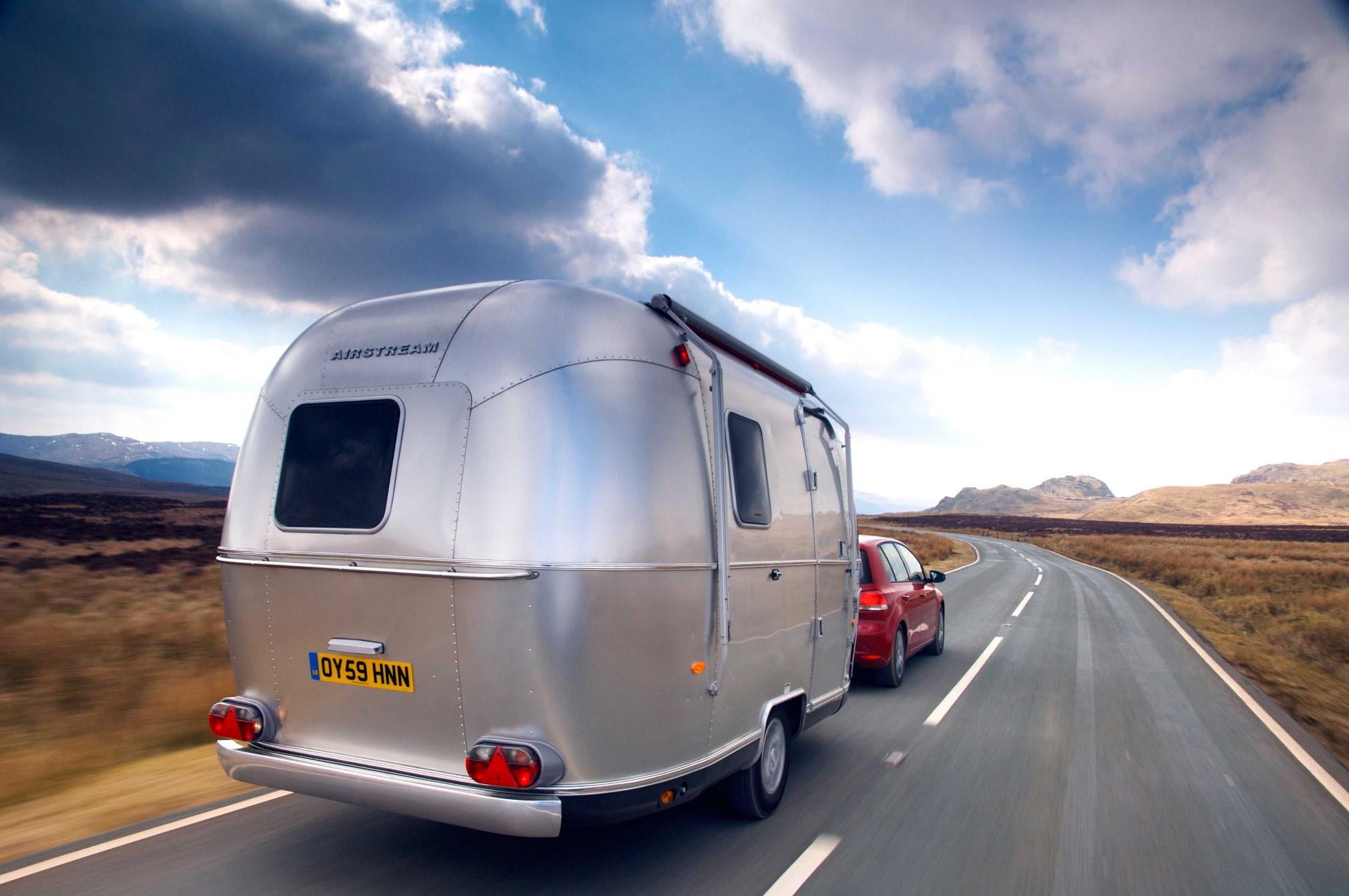
The quick and easy response would be to say that the litigious US doesn’t want you towing something that big with something small or some type of small car hating conspiracy cult or something like that but what about science? Can science help? It turns out that it can! After little thought I decided to investigate, I mean how hard could it be? Its not like its rocket science.
Given that I only managed one year in my mechanical engineering program before switching to communications, !!!error: Indecipherable SUB-paragraph formatting!!! , my first step was to consult a rocket scientist. He promptly told me we was busy doing science things but turned my attention to a !!!error: Indecipherable SUB-paragraph formatting!!! written in 2008 by Delphi published by the SAE, to investigate the dynamic properties of articulated vehicles (cars and trailers...see sciency already!) and the effectiveness of trailer sway mitigation techniques.
It’s pretty math heavy and I’m not sure I understand it completely but from it I gleaned a lot of information. Here goes:
There are a lot of variables of physics that act on a trailer and vehicle combo that are outside the scope of traditional vehicle dynamics, don’t believe me? Bam!
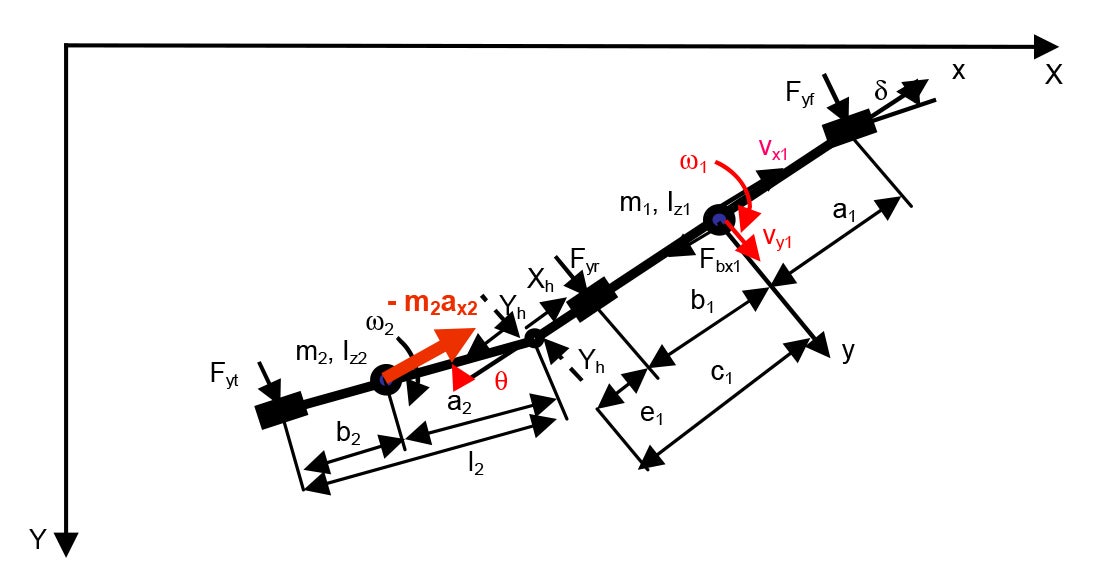
Dem physics! Mmm! There is roll, yaw, yaw stiffness, static stability and dynamic stability (oscillation) and a host of variables that interplay with the host vehicle but to simplify this article and to dilute the science to a point I can understand I’m going to focus on the one that causes the most trouble; dynamic stability, sway or as James May likes to say a “Tank slapper”.
For reasons that the math savvy will understand the basic conclusions are these:
The effects of dynamic instability are relative to speed
The speed at which the effects become an issue lowers based on the following variables:
Dynamic instability increases as the mass of the trailer gets larger in relation to the mass of the tow vehicle (trailer to tow vehicle ratio)
Dynamic instability decreases as the center gravity moves back in relation to the axle
Vehicle wheelbase affects stability
among others not covered (lateral stiffness pivot point to rear tow vehicle axle, etc)
The meat of it comes in with the center of mass and its relationship to the trailer axle center line: When the center of mass is ahead of the axle (B2 in the above diagram) stability is increased and as the distance B2 gets smaller stability is reduced.
As it related to speed, the study looks at variables in center of mass in relation to axle placement and vehicle speed as a function of whether the trailer is likely to sway and particularly at what speed it will be a decaying oscillation (takes care of itself) or an exponential oscillation (building to a crash)
Here is what they found:
First they wanted to know what kind of stability a truck had on its own, described by a damping ratio, simplified: positive ratios mean stability (decaying oscillations) and negative damping ratio means the opposite.
Up to 100 mph and beyond, the truck had a damping ratio ranging from 1-.5...stable.
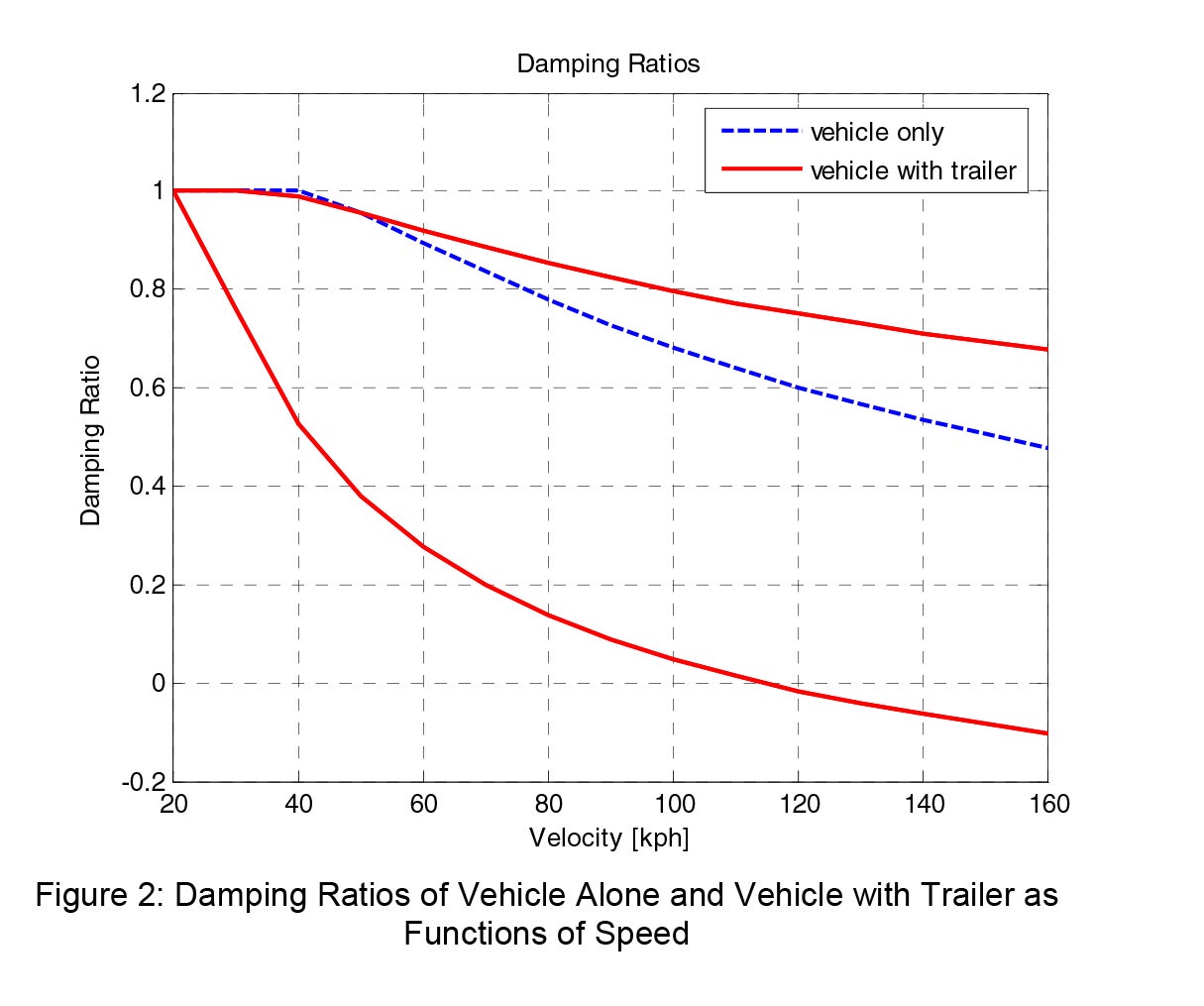
With a trailer in tow the tow vehicle’s damping ratio actually improved but the trailer showed a damping ratio that ranged from .3 at 37 mph and crossed into the negative at 71 mph. 71 mph would be considered the threshold for stability meaning that; at that speed your oscillations would neither decrease or get worse.
This is using a mathematical model with numbers that I didn’t find, but they do publish a real word confirmation study that tests 3 different configurations with variable speed.

In the first configuration the center of mass is in front of the axle(s) and the tongue weight is ~10%

In the second configuration they move the center of mass to just in front of the axle with the tongue weight at ~3%

In the final configuration they put the center of mass behind the axle line with a -10% tongue weight. The results are predictable for people who’ve experienced these scenarios first hand.
In the first example, the truck and trailer remained stable up to and beyond 100 mph.
In the second example the truck and trailer crossed a stability threshold at 65 mph.
In the third example the truck and trailer crossed a stability threshold at 45 mph.
So what? !!!error: Indecipherable SUB-paragraph formatting!!! already told me to put the trailer weight more to the front than the rear what does this have to do with US tow ratings!
Settle down, I’m getting there.
As we’ve pretty clearly established, towing a trailer is much more complex that simply “I have the HP to pull this” and even with a great cooling system a monster engine and trailer brakes you can’t just hitch up any weight you want and just because you got up to speed, assume you are good to go. That’s not to say these things aren’t important factors in towing safety, just beyond the scope of this discussion.
Every vehicle has a weight limit, called the GVW (Gross Vehicle Weight) GVWR (Gross Vehicle Weight Rating) or MAM (Maximum Allowed Mass) that stipulates how much weight the vehicle can safely handle. In addition there are Gross Axle Weight Ratings (GAWR) that stipulate how much weight can safely be carried over a given axle. Despite what some people tell you, these are serious numbers and should not be ignored if you want to avoid a fiery death.
A GVWR minus the curb weight is how much you can put in your vehicle (persons, gear and fuel) so long as that weight is distributed in a way that it doesn’t exceed the GAWR of the front or rear axles and is sometimes called the cargo carrying capacity or payload. Lets use as an example a 2014 Jeep Wrangler unlimited Rubicon.
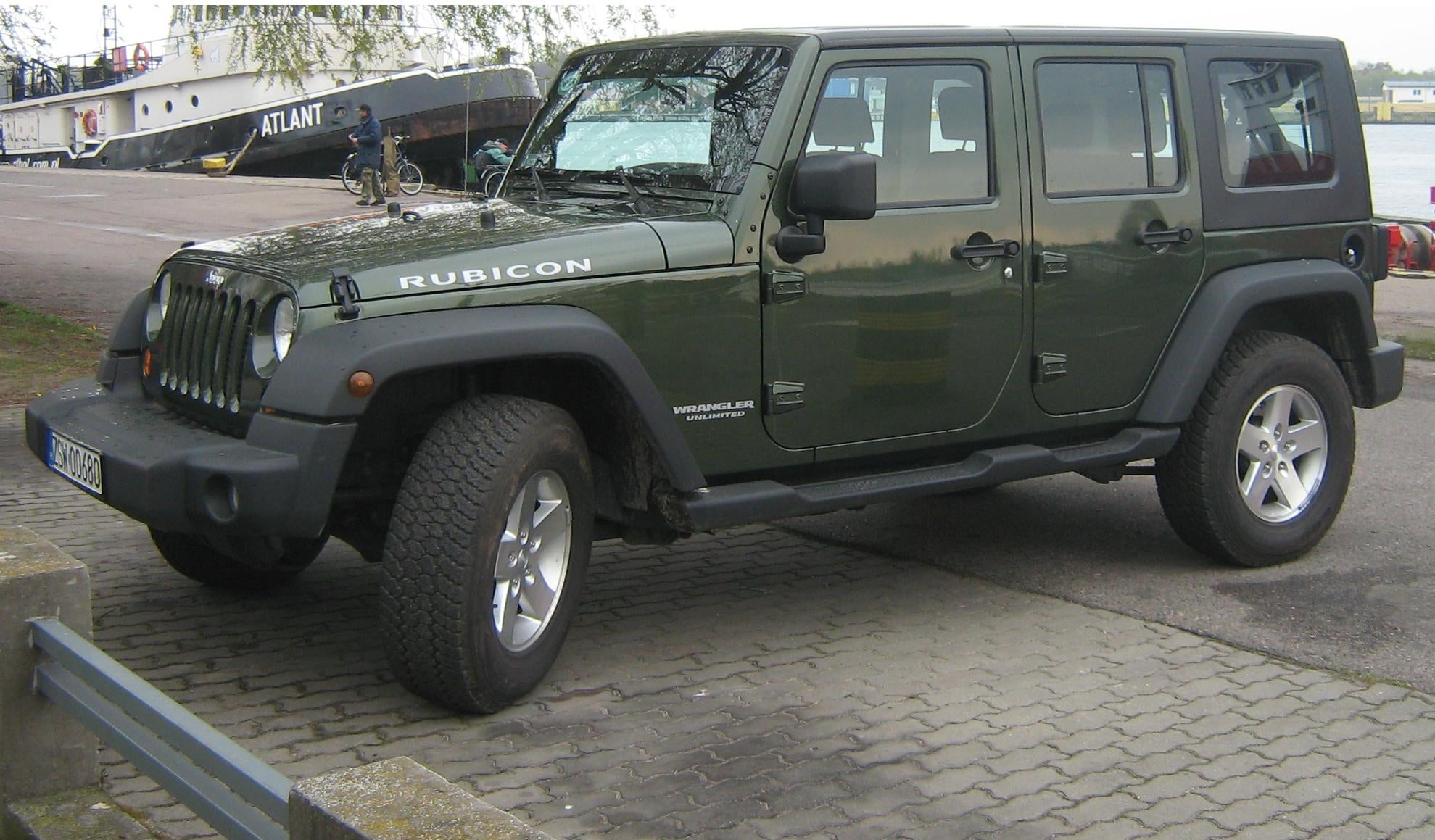
photo: wikipedia commons
With a curb weight of 4,330 (manual or course) and a GVWR of 5400 it means you can safely put 1070 lbs of people fuel and gear in there before reaching a point of safety concern.
It’s been established in this technical paper that having the trailer axles be behind the center of mass is ideal (too far behind creates other non-dynamic problems I’m ignoring for the sake of this article) but as you do that you increase the tongue load, and consequently the amount of weight on the rear axle and at the same time you un weight the front axle (not good). Using 10% as a rough guide (most in the US recommend 10-15%) shows between 100 and 1000 lbs on the rear axle based on how heavy your trailer is (1,000-10,000 lb trailer weights). Doing this gives the trailer a good base stability point but also loads the tow vehicle up and weighs down the GVWR and, more importantly, the GAWR. Given the trailer weight at the beginning of this article (4000 lbs) and using the 10-15% formula, its easy to see how 400-600 lbs, plus passengers and cargo on the rear axle could easily max out the GAWR for the forester (given the GVWR - Curb is only 900 lbs) so the question then is...how to do they do it elsewhere?
The answer is simple but first, lets summarize the physics:
The worse the ratio between trailer and tow vehicle mass the easier it is to have oscillations and the more likely they will be uncontrollable.
10-15% tongue weight with the mass in front of the axle is ideal for dynamic and static towing
The greater the tongue weight the more compromised a tow vehicle’s suspension attitude, GVWR and GAWR become.
Speed amplifies any of these problems (low tongue weight, high trailer to tow vehicle mass ratio, etc)
Okay, so for this article and in keeping with the top gear theme I looked up how you tow a trailer in the UK. here is what I found.

Standard drivers license allows for 1600 lbs trailer weight if gross combined is less than 7700 lbs (vehicle and trailer)
E entitlement (additional licensing) for towing above 7700 lbs gross combined. Unless you got your license before 1997, then its up to 18188 Gross combined.
26455 lbs gross combined weight (trailer and vehicle) requires a C1+E license.
Trailer size restrictions are 22 feet x 8.33 feet up to 7700 lbs gross combined.
All trailer above 1600 lbs to have trailer brakes
Max tow speed 60 mph on motorways (slower on other roads)
Drawbar nose weight 4-7% (150-330 lbs total max) recommended
In the US, these laws vary state to state so I picked a conservative state where towing heavy loads by the masses is pretty normal; Utah.

Class A drivers license allows for up to 26,000 Gross combined vehicle (trailer and vehicle).
26,001 requires a CDL for hazmat, 16+ passenger, articulated gross combined or commercial towing.
Trailer size restrictions are 14 height x 8.5 wide and 65 combined train length.
All trailers 2000 lbs and up require trailer brakes.
Max tow speed is the standard passenger car limit (65-80 mph) unless posted.
Tongue weight max 100-1000 depending on receiver class (draw bar, more for 5th wheel)
Compared to the US, UK drivers can tow less weight and size without a special license and the max motorway speed is 60 versus up to the legal limit (or the trailer tire speed rating, which ever comes first). Why the difference?
The most important number to look at is the % of weight over the “nose” or tongue for the UK vs the US. In the UK, the thinking is that if you reduce the tongue weight you can pull more without risking maxing your GAWR out or nosing up the vehicle dangerously and as a result the trailers have their mass much more centralized over the axle which means that the only thing the tow vehicle needs to do is pull in a line, which is less stress on the components. Sounds good right?
However, if you’re still awake you will recall that at low tongue weights with the trailer mass more closely centered to the axle you have a much increased risk of destabilizing oscillations. Given that the trouble really starts, according to the math and the real world example, around 65 mph its no wonder that the UK has a strict limit on trailing and why Jeremy Clarkson has a rational hatred of caravans.
To boil it all down, the reason that American vehicles are rated to tow less is based on a difference methodology for tow safety.
US tow safety prioritizes a naturally safe dynamic situation so that more people can pull at freeway speeds with less likelihood of incident. There is no doubt that using this method results in an inherently safer tow situation as it relates to vehicle dynamics.
UK tow safety allows for the possibility to carry more weight, but erring on the side of caution with far less safety margin in respect to the physics.
Bottom line - Can a tow vehicle pull a heavier trailer there than is rated for here in the US? Yes, with some provisions:
1. The closer the trailer weight gets to the vehicle weight the slower you will need to drive.
2. DO NOT exceed 65 mph with a tongue weight in the 4-7% range, this is a guaranteed way to sway and 65 is the max, go slower in regards to #1.
3. None of this takes into account crosswinds, cooling systems, hp, or braking effectiveness (or legality).
!!! UNKNOWN CONTENT TYPE !!!
Moral of the story
!!! UNKNOWN CONTENT TYPE !!!
Europeans! Be proud that you can pull that huge caravan with your tiny car.
Americans! Be proud you can pull more weight in total and with a greater degree of safety and at higher speeds than our Euro friends.
Note: DON’T assume for one second, Americans, that you can simply use Europe as a guide to towing above your limit, its not going to be safe at our speeds DON’T put me and my family in danger or embarrass us in front of the other countries.
 Tom McParland
> HammerheadFistpunch
Tom McParland
> HammerheadFistpunch
07/23/2014 at 11:41 |
|
This is an excellent post! Science FTW!
 HammerheadFistpunch
> Tom McParland
HammerheadFistpunch
> Tom McParland
07/23/2014 at 11:43 |
|
Thanks Tom, I was bothering me to no end for some reason why there was such towing disparity between us and the European world.
 dinobot666
> HammerheadFistpunch
dinobot666
> HammerheadFistpunch
07/23/2014 at 11:48 |
|
I was driving back from Kentucky a few years ago, and a lady in a Ford Expedition was towing a dual axle 6x12 trailer at about 75 mph. About every 10 minutes or so, the whole assembly of the Expedition and the trailer would shimmy back and forth violently, to the point where I thought she'd go off the road.
I tried to keep my distance behind her to avoid an accident, but when I finally decided to pass her after about the 10th shimmy death wobble, I noticed that she was on her cell phone and didn't even react to the vehicle she was driving nearly going out of control.
One of the scariest things I've seen on the road.
 twochevrons
> HammerheadFistpunch
twochevrons
> HammerheadFistpunch
07/23/2014 at 11:49 |
|
I'd like to see that kind of restriction on towing over here. Just because you got your regular license (which is a joke in its own right in many states), doesn't mean that you know how to tow a huge trailer safely.
 William Byrd
> HammerheadFistpunch
William Byrd
> HammerheadFistpunch
07/23/2014 at 11:49 |
|
Wow, well done. To the FP with this!
 FJ80WaitinForaLSV8
> HammerheadFistpunch
FJ80WaitinForaLSV8
> HammerheadFistpunch
07/23/2014 at 11:50 |
|
Can't wait to read this at lunch. I just rented a 6x12 uhaul trailer to move this weekend.
 HammerheadFistpunch
> FJ80WaitinForaLSV8
HammerheadFistpunch
> FJ80WaitinForaLSV8
07/23/2014 at 11:51 |
|
Where are you moving to?
 Jcarr
> HammerheadFistpunch
Jcarr
> HammerheadFistpunch
07/23/2014 at 11:53 |
|
Excellent piece! As a fellow communications major (now working in commercial real estate investment consulting, go figure), the Simpsons reference/link was the cherry on top.
 macanamera
> HammerheadFistpunch
macanamera
> HammerheadFistpunch
07/23/2014 at 11:55 |
|

 Klaus Schmoll
> HammerheadFistpunch
Klaus Schmoll
> HammerheadFistpunch
07/23/2014 at 11:57 |
|
Be aware that in most European countries ALL vehicles with a trailer have to obey a 50 mph speed limit. Might this have something to do with the different towing capacities as well?
 JawzX2, Boost Addict. 1.6t, 2.7tt, 4.2t
> HammerheadFistpunch
JawzX2, Boost Addict. 1.6t, 2.7tt, 4.2t
> HammerheadFistpunch
07/23/2014 at 11:58 |
|
Excellent and very complete, thanks for the info!
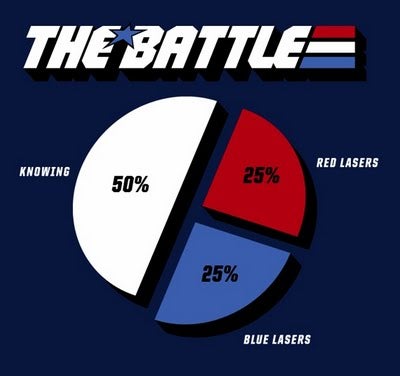
 FJ80WaitinForaLSV8
> HammerheadFistpunch
FJ80WaitinForaLSV8
> HammerheadFistpunch
07/23/2014 at 11:59 |
|
Three blocks down the road in DC. The price difference for the big trailer vs a small trailer was negligible.
 HammerheadFistpunch
> Klaus Schmoll
HammerheadFistpunch
> Klaus Schmoll
07/23/2014 at 12:00 |
|
I mentioned that in the article, for the UK, the max motorway speed was 60, for other countries it may be lower.
 CAR_IS_MI
> HammerheadFistpunch
CAR_IS_MI
> HammerheadFistpunch
07/23/2014 at 12:01 |
|
My 2 points.
1: This is also why trucks with 5th wheel / gooseneck hitches can tow more, as the tongue weight is more evenly distributed to the center of the rear axle.
2: A good part of what goes in to calculating stability rates and eventual GVWR on a vehicle is related to suspension components. Since you used a Jeep in your article and I own a Jeep I can confirm that the axles can take a lot more than they are rated for (especially the Saharas and Rubicons with Dana 44's), but the suspension bits that help keep the vehicle level and straight have limitations as well.
 HammerheadFistpunch
> CAR_IS_MI
HammerheadFistpunch
> CAR_IS_MI
07/23/2014 at 12:06 |
|
Excellent points, the main problem with the jeep is that the front suspension design is made for max flex and has little lateral stiffness and as a consequence cornering stability suffers quite badly when loaded, especially rear loaded. If you check out the technical document there is a great deal of explanation on an understeer quotient that deals with the vehicle and the articulated vehicle combo, in both cases lateral stiffness plays a large part in the damping ratio. It was beyond the scope of this article so i omitted it.
 horspowr1001
> HammerheadFistpunch
horspowr1001
> HammerheadFistpunch
07/23/2014 at 12:09 |
|
TOW DOWN FOR WHAT

 HammerheadFistpunch
> horspowr1001
HammerheadFistpunch
> horspowr1001
07/23/2014 at 12:10 |
|
dems some exponential oscillations!
 CAR_IS_MI
> HammerheadFistpunch
CAR_IS_MI
> HammerheadFistpunch
07/23/2014 at 12:14 |
|
Yea these damned things have a hard time driving straight when they aren't loaded, nevermind if you add a trailer.
 thebigbossyboss
> HammerheadFistpunch
thebigbossyboss
> HammerheadFistpunch
07/23/2014 at 12:15 |
|
Wow. You are smart. Now...tell that to the guy towing the boat that passed me when I was goin 70.
 HammerheadFistpunch
> CAR_IS_MI
HammerheadFistpunch
> CAR_IS_MI
07/23/2014 at 12:16 |
|
Short wheelbase, poor lateral stability in the suspension, poor tire stiffness (another factor)...Hence: no renting a trailer at U-Haul with a 2 door wrangler. Too much potential for disaster.
 HammerheadFistpunch
> thebigbossyboss
HammerheadFistpunch
> thebigbossyboss
07/23/2014 at 12:18 |
|
Boats are GREAT for stability, they typically have their axles far back and their mass is ideally located on the trailer and ball, so long as the guy isn't being a complete moron this is totally safe. The speed limit here in parts of utah is 80 and people pull their boats at that speed all the time with no problems...granted you have to make sure to switch from bias ply (max speed 65) to radials with the proper load rating, but it aint no thang if its done right.
 thebigbossyboss
> HammerheadFistpunch
thebigbossyboss
> HammerheadFistpunch
07/23/2014 at 12:21 |
|
Oh ok I didn't really know it could be done safely I was just like "damn man, you haulin"
I did read your article, but I guess I didn't consider it's applications.
 Two Drink Minimum
> HammerheadFistpunch
Two Drink Minimum
> HammerheadFistpunch
07/23/2014 at 12:24 |
|
Why do I feel like this needs a Polandball cartoon?
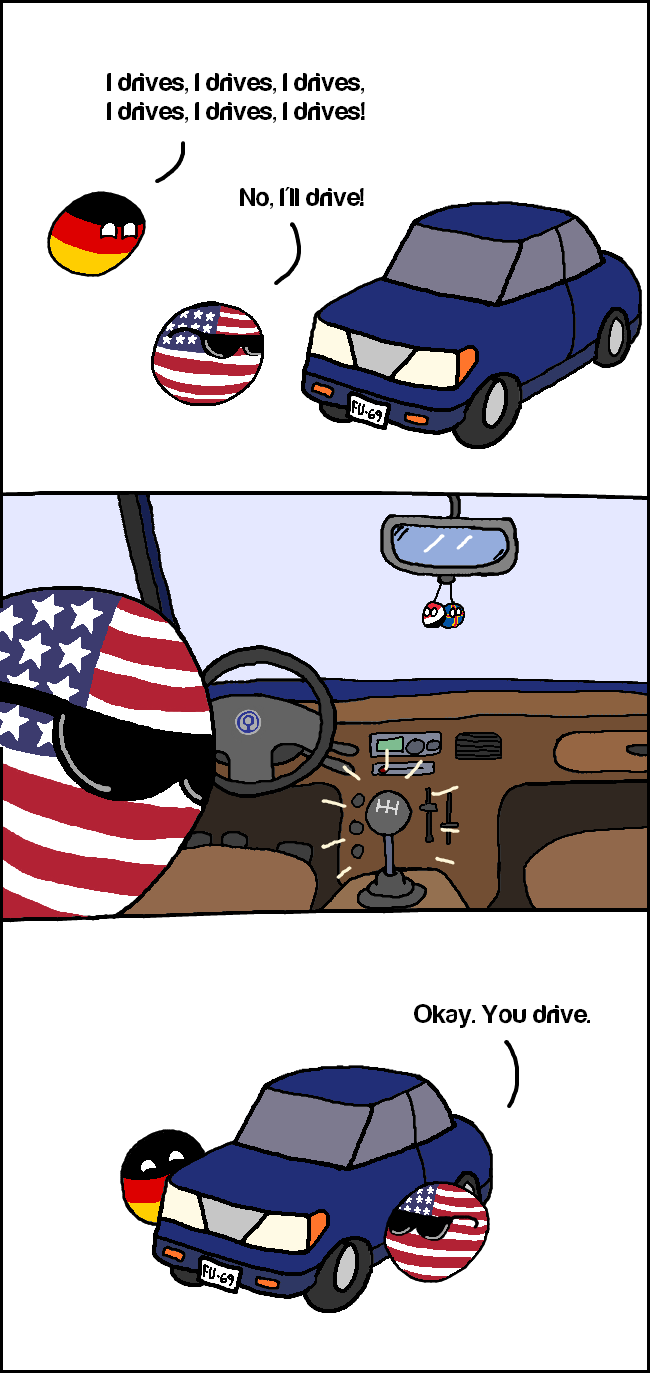
 Racescort666
> HammerheadFistpunch
Racescort666
> HammerheadFistpunch
07/23/2014 at 12:24 |
|
Great write up. I've towed a lot but never seen the study with physics behind it. A lot of this stuff you kind of start to figure out from towing things frequently.
 feather-throttle-not-hair
> HammerheadFistpunch
feather-throttle-not-hair
> HammerheadFistpunch
07/23/2014 at 12:28 |
|
this terrifies me, I hope I never have to pull a trailer.
 WhiskeyGolf
> HammerheadFistpunch
WhiskeyGolf
> HammerheadFistpunch
07/23/2014 at 12:38 |
|
Great article! I've always wondered this myself. The only thing my family really tows is a 17ft bowrider (3000 lbs combined boat and trailer) and we're right at about the safe limit for our vehicle (Mazda Tribute). Like you mention below, boats are well suited to trailering and our trailer is designed specifically for our boat so we have had no issues at all driving 100-110 km/h.
 cabarne4
> HammerheadFistpunch
cabarne4
> HammerheadFistpunch
07/23/2014 at 12:38 |
|
So what you're saying is, a Fozzy can tow nearly 4,000 lbs if tongue weight is around 5% and speed is kept under 60mph.
That's genuinely the guidelines I go behind. Keep within weights, capable of towing at speed. Towing a heavy load, keep the tow vehicle under GVWR (otherwise risk damaging suspension) and keep speed low. I generally would tow a heavy load at 55-60mph.
Granted, I've only towed with mid-sized pick-ups. Haven't tried towing with a wagon / hatch, but I'm definitely interested in knowing the capabilities (at different speeds) of an average wagon / hatch.
 Dusty Ventures
> feather-throttle-not-hair
Dusty Ventures
> feather-throttle-not-hair
07/23/2014 at 12:38 |
|
It's intimidating at first, but if you're smart it gets easy quick.
 HammerheadFistpunch
> WhiskeyGolf
HammerheadFistpunch
> WhiskeyGolf
07/23/2014 at 12:39 |
|
It is not the greatest tow car in the world, it is only a tribute .
Canada?
 zeontestpilot
> thebigbossyboss
zeontestpilot
> thebigbossyboss
07/23/2014 at 12:39 |
|
Don't feel bad, we all say that as they fly by.
 Dusty Ventures
> HammerheadFistpunch
Dusty Ventures
> HammerheadFistpunch
07/23/2014 at 12:40 |
|
Great article! I've always been curious about this myself. I've also towed various trailers with various vehicles at various speeds with varying degrees of sketchiness, all of which is quantified quite well by your post.
 HammerheadFistpunch
> cabarne4
HammerheadFistpunch
> cabarne4
07/23/2014 at 12:43 |
|
Im pretty sure I said NOT to do that
"Note: DON'T assume for one second, Americans, that you can simply use Europe as a guide to towing above your limit, its not going to be safe at our speeds DON'T put me and my family in danger or embarrass us in front of the other countries."
 HammerheadFistpunch
> Dusty Ventures
HammerheadFistpunch
> Dusty Ventures
07/23/2014 at 12:45 |
|
Thanks Dusty, This question always bugged me, glad to have it ticked off the list. now on to greater matter, like why Mike and Ike had to split up. Man I'm glad they are back together.
 thebigbossyboss
> HammerheadFistpunch
thebigbossyboss
> HammerheadFistpunch
07/23/2014 at 12:47 |
|
Also that's the other thing....I am like "Bro what speed your dinky tires rated for?" lol.
 catkam623 misses his 944
> HammerheadFistpunch
catkam623 misses his 944
> HammerheadFistpunch
07/23/2014 at 12:53 |
|
God damn that's a lot of science I understood most of it but thats really quite complex. does the saw take into account crosswinds and other independent variables upon rating vehicles?
 cabarne4
> HammerheadFistpunch
cabarne4
> HammerheadFistpunch
07/23/2014 at 12:54 |
|
"not going to be safe at our speeds..."
Like I said, keep speed down and it's safe. Towing 3,500 lbs with a Fozzy is no different in AUS vs USA. The only difference is the average American will think it's safe to try and keep up with traffic at 80mph. I'm perfectly fine in the right lane doing 55-60mph if I'm towing, which (as you point out using SCIENCE!) is relatively safe to do.
 duurtlang
> HammerheadFistpunch
duurtlang
> HammerheadFistpunch
07/23/2014 at 12:55 |
|
In the majority of continental Europe it's lower. 80 or 90 km/h, or 50 or 56 mph. Even on the unrestricted German Autobahn you are not allowed to drive faster than 50 mph, no matter how capable the tow vehicle or how tiny the trailer. Unless you've got a special Tüv approved trailer, then the maximum speed is 100 km/h (62 mph). GVWR over 3,500 kg (7,716 lbs)? Always 50 mph max, even on the unrestricted autobahn.
 HammerheadFistpunch
> cabarne4
HammerheadFistpunch
> cabarne4
07/23/2014 at 12:56 |
|
im advocating not doing it...but the science is on your side.
 HammerheadFistpunch
> duurtlang
HammerheadFistpunch
> duurtlang
07/23/2014 at 12:57 |
|
The one things I can't answer with this article is this:
Is it safer to force people to tow slowly, or tow less?
 duurtlang
> HammerheadFistpunch
duurtlang
> HammerheadFistpunch
07/23/2014 at 13:02 |
|
I think it's safer to make people learn about towing and the dangers associated with it before allowing them to do so.
I personally flat out refuse to tow anything without getting the towing license (and the associated training), even though I'm allowed to tow similar loads as the British.
 Twingo Tamer - About to descend into project car hell.
> HammerheadFistpunch
Twingo Tamer - About to descend into project car hell.
> HammerheadFistpunch
07/23/2014 at 13:03 |
|

 nermal
> HammerheadFistpunch
nermal
> HammerheadFistpunch
07/23/2014 at 13:03 |
|
Europeans can also get a BMW 325D with a manual and 1800KG tow rating, and one of these extendable erection hitches.
It would be even better if you could remotely control the hitch deployment, as a method of rudimentary car-to-car communications, in case you pass and attractive lady....
 WhiskeyGolf
> HammerheadFistpunch
WhiskeyGolf
> HammerheadFistpunch
07/23/2014 at 13:04 |
|
It's worked really well so far, but the primary downside is that the V6 is pretty unrefined and you basically pay for near tow fuel economy for normal driving, but that is the constant tow vehicle issue.
Yep, that's our traditional fresh season 24gal fill up at the beginning of the season in Orillia, Ontario. That part of the country has some of the best freshwater boating in the world.
 cabarne4
> HammerheadFistpunch
cabarne4
> HammerheadFistpunch
07/23/2014 at 13:05 |
|
I'm of the opinion that if you're properly braked and balanced, and keep the tow vehicle under its GVWR, you're good to go ***assuming you keep your speed relative to the load***.
Now, when safe speed is vastly different from average vehicle speed on a stretch of road, it's once again dangerous — but only because you become a rolling road block. So there's definitely a balance to be found between what US manufacturers quote and what is actually bordering on too slow or too dangerous.
I've had to tow loads for work that push the limits of a mid-sized pick-up. And the way our loads are / our trailer is, we can't always get the ideal balance / tongue weight. With these loads, I keep speed way low (55mph max), and avoid interstate highways when possible. I also will not tow a load that large on routes that require large inclines (uphill or downhill). Adding hills into the mix drastically changes your limitations (with regards to cooling and braking capabilities).
That said, I've seen someone drop $65,000 on a loaded F-350 because he occasionally tows two jetskis. The jetskis with trailer weigh way under 1,500 lbs. No doubt he's safe to tow them, I just think it's ridiculous people go out and buy way too much truck because they think they "need" it to tow. The only sound argument I've heard for this is potentially upgrading trailers later on. If this guy decides to buy a travel trailer down the road, he won't have to limit himself based on what tow vehicle he has.
 HammerheadFistpunch
> duurtlang
HammerheadFistpunch
> duurtlang
07/23/2014 at 13:08 |
|
What I find so interesting is that based on the math and what I've seen on top gear as it related to articulated stability is how easy it is to get oscillations with the low nose weight that is the Euro norm, vs here where trailer sway is very uncommon following the common sense stuff and sticking to the 10-15% equation. On the one hand, less natural sway is great! More stability for all! On the other, when it does happen its so rare or uncommon that people don't have the slightest idea how to correct it. I had trailer sway for the first time in years pulling my new camp trailer (3400 lbs with my cruiser rated for 5000 lbs US) and i was all "what the hell is this? what am i supposed to do again?" After figuring out why it was swaying (a slightly nose up attitude on the trailer and consequently not enough tongue weight) it solved itself, though now im a little more cautions on fast downhill roads.
 HammerheadFistpunch
> nermal
HammerheadFistpunch
> nermal
07/23/2014 at 13:09 |
|
Oh Europe and your penis hitch...maybe the science is meaningless and it all boils down to "we can tow more than you Americans!"
 HammerheadFistpunch
> cabarne4
HammerheadFistpunch
> cabarne4
07/23/2014 at 13:14 |
|
Just be aware that the damping ratios with a low tongue weight are lower across the board, 65 is where they go negative but at speeds above 35 you are in an area where oscillations are likely to occur, they are just decaying, not exponential. Approaching a damping ratio of 0 is the danger zone, I would stick to 50-55 to be safe and aim for a tongue weight of 5% or so. Granted I think you are being very practical and smart about this, but just to point out that even with a 10-15% tongue weight you are still able to induce sway so it will be much worse with lower tongue weights.
 TJDMAX
> HammerheadFistpunch
TJDMAX
> HammerheadFistpunch
07/23/2014 at 13:14 |
|
Awesome article. I would like to add a few other points to this as well. Besides the weight control and sway control it is typically easier to maneuver a trailer with a truck. They tend to have tighter turning radii which helps backing boats down ramps, or trailers into camping spots etc. There is also a ratio when too long of a tow vehicle (distance from pivot point to steer axle) and too short of a trailer makes for a very interesting maneuvering situation. Ever try backing a jet ski trailer down a boat ramp...much harder to do than backing down a boat trailer.
Another point to make, and this goes more towards the difference in our two societies outlooks on camping, but look at the typical camping trailer size in America and compare it to that of one in Europe. Camping trailers especially are built to be very light weight. very thin material construction, cheap construction etc. Not only are their trailers shorter in length but they tend to be narrower and shorter in height as well, thus the weight of the trailer is much less and the surface area decreased meaning that its not AS effected by wind as a larger trailer would be. Sure we have small camping trailers here in America but the majority of the ones on the road that we see being pulled by families are 23+ ft in length, have 1-4 slideouts, 2-3 axles, they have fire places, granite counters, tile floors, leather full size couches etc...The point being is that our trailers are much more lavish if you will than what i have seen of European campers. Thus the weight of the trailers and everything here is more, meaning having a tow vehicle that weighs more and can tow more is "necessary". I say necessary in quotes because clearly camping doesn't have to be as lavish or big as we have here, but it is what it is and truck manufactures have to keep up with camping and boating lifestyles.
My opinion is that i would much rather have people that are going to tow bigger boats and campers etc tow them with vehicles that have greater capacities than what their owner needs. Its always nice to have more weight/power/brakes in front of the trailer if something were to happen to the trailer like losing breaks or blowing out a tire etc.
 erikgrad
> HammerheadFistpunch
erikgrad
> HammerheadFistpunch
07/23/2014 at 13:17 |
|
Great post, and a timely one for me. I've been looking at camping trailers for the last month, and started to think the low towing capacity on my vehicle was BS due to the ratings of the same platform across the pond. You seriously may have saved me from doing something stupid.
 TJDMAX
> HammerheadFistpunch
TJDMAX
> HammerheadFistpunch
07/23/2014 at 13:18 |
|
Slower. For people that aren't experienced towers, if something is going to go bad while towing (uncontrollable sway, blow out, loss of trailer brakes, etc) it'll happen in a hurry as is, adding more speed to the equation is much worse than having to deal with a bigger load. If the tow vehicle is within (or near) its tow ratings and weight ratings, if something happens with the trailer the vehicle and operator should still be able to control that load as a unit. Towing faster just means everything will happen faster or more harshly.
 HammerheadFistpunch
> TJDMAX
HammerheadFistpunch
> TJDMAX
07/23/2014 at 13:21 |
|
Very good points. The technical document refers to the static issues you bring up as well, but I ommited them for the sake of clarity. Regarding camp trailers, I think you are right about the size but the wrong conclusions. I think the reasons we have more lavish trailers is because we can. Even if you could find a tow vehicle that could safely tow the heavier trailers you need special licensing to be able to do it, so people are incentivized to buy lighter and smaller trailers. Chicken and Egg thing.
About the tow vehicle, my rule of thumb is to buy a tow vehicle with 15% more (minimum) Tow rating to your trailers GVWR. Part of that is the brakes and mass issue, which is born out in the math, and part of that is that I live at elevation and I need the extra power to compensate for power loss at altitude and towing up grades. the heaviest trailer I've towed with my 5000 lb rated cruiser is 3500 lbs.
 HammerheadFistpunch
> erikgrad
HammerheadFistpunch
> erikgrad
07/23/2014 at 13:22 |
|
glad to hear it. I was in the same boat...then I sold my forester and bought a cruiser and a 3500 lb popup.
 HammerheadFistpunch
> Twingo Tamer - About to descend into project car hell.
HammerheadFistpunch
> Twingo Tamer - About to descend into project car hell.
07/23/2014 at 13:30 |
|
Hi anamatronio!
 cabarne4
> HammerheadFistpunch
cabarne4
> HammerheadFistpunch
07/23/2014 at 13:31 |
|
There's also more to the equation than weights and balances. Obviously a 5th wheel / gooseneck will be more stable, but even bumper pulls have different hitch types. A weight distributing hitch, for example, allows for a higher tongue weight (15-20%, conservatively) with less lifting effect on the front wheels. An anti-sway hitch has a mechanical brake on an arm that slides out and in as the trailer moves independently of the vehicle. If the trailer starts to sway, the brake "grabs" the arm and gives it more resistance to sway. Having an independent brake controller is equally important. Asides from being able to adjust strength and gain of the brakes (how hard they bite and how much delay there is between pressing the stop pedal and the trailer brakes reaching full stop, respectively), most brake controllers have a control to independently brake the trailer. If you start to get sway, braking the trailer independent of the tow vehicle will usually straighten it out.
One big difference between Euro / AUS towing and US towing is this independent brake controller. A European camper, for example, usually uses manual trailer brakes. Basically there's a pressure sensor or switch on the back inside of the "cup" that sits over the ball. When you hit the brakes, the trailer doesn't slow initially, and "pushes" on the car. This puts pressure on the back side of the cup and ball, which activates the switch, which activates the trailer brakes. Modern trailers use electronic sensors / electronically actuated brakes for this. Regardless, they're missing out on the ability to brake the trailer independently of the vehicle in the event of sway.
 HammerheadFistpunch
> catkam623 misses his 944
HammerheadFistpunch
> catkam623 misses his 944
07/23/2014 at 13:31 |
|
in a way, laterally stability (through the tires and axle) are a key component in controlling oscillations so it could be assumed that another lateral force like wind would factor in the same way.
 HammerheadFistpunch
> cabarne4
HammerheadFistpunch
> cabarne4
07/23/2014 at 13:35 |
|
the technical doc linked is actually a study is trailer sway mitigation, not so much in articulated dynamics and it addresses several methods for mitigating sway electronically and physically. Friction sway controllers are partially effective, but only when the damping ratio is greater than 0, in the negative values, they wont do much. In regards to electronic brakes vs surge brakes, very true...surge brakes suck balls but are still better than no brakes at all.
 TJDMAX
> HammerheadFistpunch
TJDMAX
> HammerheadFistpunch
07/23/2014 at 13:36 |
|
That is true. Its the same issue across the entire vehicle range difference between America and the rest of the world basically. We have big trucks because we can and want to have them, when everyone else gets by just great with smaller vehicles. Definitely a chicken and egg debate.
Being and engineer and working in the automotive industry I am well aware that everything in vehicles, every rating, for anything not just vehicles, has a factor of safety. This is why when you see a pickup towing a trailer above what the tow vehicle is rated for its not blowing up with parts flying off of it. Not to say that people should bank on the fact that they can overload their vehicles all the time, they should still stick below ratings, but its comforting to remember that the ratings given are typically a good amount lower than what the true max is. Also, not all factor of safeties are the same...so there's no way of knowing what a true max rating is for any vehicle unless you happen to be the engineer that designed the vehicle i suppose.
I think we are on the same page though, Definitely a stellar write up, and great job "dumbing down" the intense math and such for everyone.
 catkam623 misses his 944
> HammerheadFistpunch
catkam623 misses his 944
> HammerheadFistpunch
07/23/2014 at 13:38 |
|
interesting but wouldn't that have different values depending on the aerodynamicity (is that a word) of the trailer or object being towed
 HammerheadFistpunch
> catkam623 misses his 944
HammerheadFistpunch
> catkam623 misses his 944
07/23/2014 at 13:40 |
|
I guess it would, in the end though it all boil down to force vectors
 HammerheadFistpunch
> TJDMAX
HammerheadFistpunch
> TJDMAX
07/23/2014 at 13:42 |
|
Rambling and I were having a debate on this the other day (safety margins) and if you can say I would like your input on what kind of margins are really built into trucks these days that are forever chasing bigger and badder tow and payload ratings. Its my feeling that the weakest link is the one to be most concerned with and at the point of sophisticated engineer we are at, I can't imagine those weak links have as large or margins as we think they do.
 catkam623 misses his 944
> HammerheadFistpunch
catkam623 misses his 944
> HammerheadFistpunch
07/23/2014 at 13:45 |
|
And would that be what the sae takes into account. I imagine they probably estimate the GAWR then take off a certain percent to alow for variables? Of course I honestly have no idea and am just speculating.
 cabarne4
> HammerheadFistpunch
cabarne4
> HammerheadFistpunch
07/23/2014 at 13:52 |
|
Agreed. Which again brings us back to speed — the greatest mitigator in trailer sway / stability. Unfortunately the report is loading way too slowly on my iPod, I'll have to wait until I'm back on a computer to read it. Sounds like a good read though!
Basically my point comes down to: US standards are safe up to the speed of traffic (generally 70-80mph). Euro / AUS standards are safe under 60/55mph. So I've got no problem towing past the US standard, so long as you're not pushing the mechanical limits of the tow vehicle's suspension and chassis (GVWR), and keep speed reasonable with regard to trailer weight and terrain.
...There's a LOT of factors at play when it comes to towing.
 If only EssExTee could be so grossly incandescent
> HammerheadFistpunch
If only EssExTee could be so grossly incandescent
> HammerheadFistpunch
07/23/2014 at 14:09 |
|
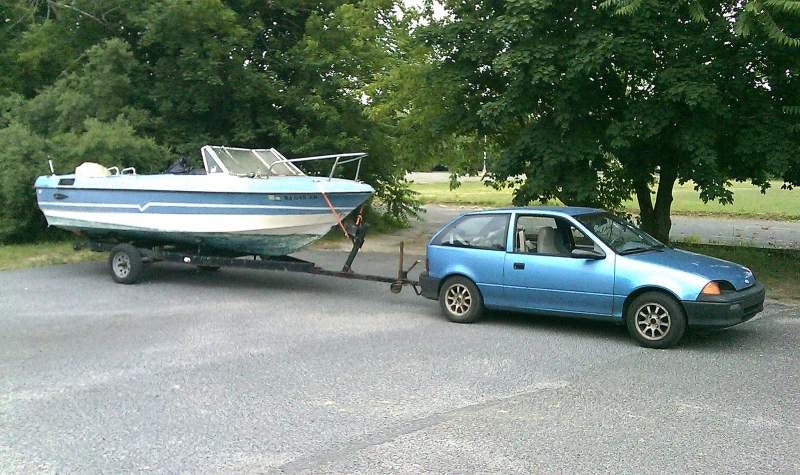
But I could technically relocate my boat with a Geo Metro, right?
 TJDMAX
> HammerheadFistpunch
TJDMAX
> HammerheadFistpunch
07/23/2014 at 14:09 |
|
Well typical factors of safeties I have seen range from 1.5 on the very low end to 4 on the upper end. Now this is not to say that a 3500 truck with a 30K tow capacity rating can tow 45K-120K pound trailers. The factor of safeties are built in to individual components. Wheel bearings for instance. Bearings have ratings for axial and radial load components. At different loads bearings are designed to last for a different amount of revolutions. You can imagine a huge bearing with a small force on it would last a lot longer and spin more revolutions before its life is over than a small bearing with the same force applied. Axle ratings are based off of bearing loads (among other things too) of the wheel or axle bearings. So by having a factor of safety on the bearings they are ensuring that they wont fail instantaneously if an axle rating for example is exceeded. Another prime example would be a pitman arm, or a drag link, components in a steering system. The manufacturer wants to keep costs down obviously, and when making a million of a part if you can save 5% of the material from one design to another you will, but steering components typically like bearings will have a higher 2.5-3 factor of safety built in to the design, meaning that they are capable of handling a force (in their intended purpose) 2.5-3 times greater than what the design engineer assumes its "worst case scenario" would be. So this is why lifted trucks with bigger wheels and tires are able to still drive down the road with the increased force required to turn larger than stock wheels.
I added "Intended Purpose" because to an OEM adding larger wheels and tires isn't an intended purpose of the truck, so that is why these components tend to wear out faster when larger wheels and tires are installed.
So how do factors of safety get back to towing, well, if you have stronger suspension bushings, wheel bearings, steering components, wheels, tires, etc it all adds up to the trucks and cars being able to tow (start, stop, steer...you know the important things) more than what the rating is.
I have to imagine that its a tricky business for OEM's when they release a towing capacity for a vehicle. On one had you want to be able to claim that you have the highest yada yada yada. But they have to know that there is a definite possibility that some owners of trucks would regularly exceed the ratings, so they have to make it low enough to allow a decent cushion for those customers to still be able to "safely" tow those heavier loads. This saves them from lawsuits or other stupid issues i'm sure that people would try and sue them for. On the other hand they have cost and manufacturing capabilities to deal with. Bigger components means more expensive components which drives up cost and there is only so much that OEM's can charge for vehicles before no one will buy them, so they have to leave themselves a decent profit margin as well. I'm just thankful I'm not the one that makes all those decisions.
 If only EssExTee could be so grossly incandescent
> HammerheadFistpunch
If only EssExTee could be so grossly incandescent
> HammerheadFistpunch
07/23/2014 at 14:13 |
|
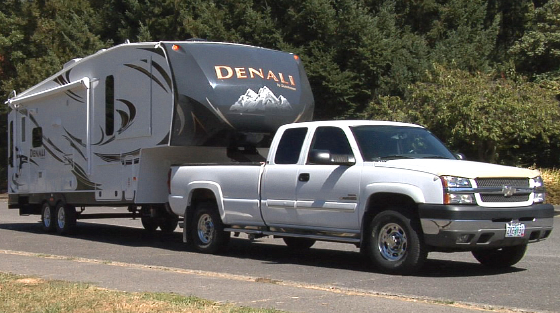
So what about fifth wheel/ gooseneck trailers? Does the different point of loading on the tow vehicle affect stability? Or is it just a matter of being able to tow more weight than a ball hitch can?
 HammerheadFistpunch
> If only EssExTee could be so grossly incandescent
HammerheadFistpunch
> If only EssExTee could be so grossly incandescent
07/23/2014 at 14:14 |
|
you can do almost anything once.
 HammerheadFistpunch
> If only EssExTee could be so grossly incandescent
HammerheadFistpunch
> If only EssExTee could be so grossly incandescent
07/23/2014 at 14:16 |
|
it does 2 things:
1. it puts the weight directly over the axle which, if you read the brief, is a good thing for stability and
2. because its directly over the axle there is less of a lever arm effect and so dynamic loading on the axle is less therefor you can get away with more tongue weight.
 If only EssExTee could be so grossly incandescent
> HammerheadFistpunch
If only EssExTee could be so grossly incandescent
> HammerheadFistpunch
07/23/2014 at 14:19 |
|
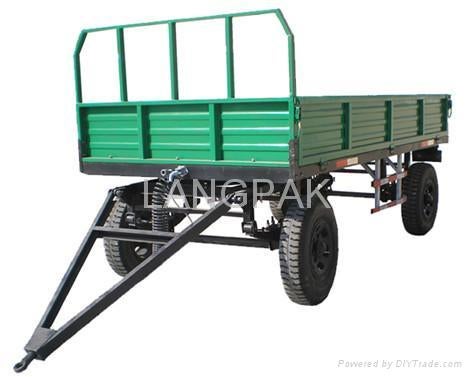
What about a trailer with the axles spread and the load between them? That would significantly decrease the load on the tow vehicle's axles, so why don't we see these ever?
 If only EssExTee could be so grossly incandescent
> HammerheadFistpunch
If only EssExTee could be so grossly incandescent
> HammerheadFistpunch
07/23/2014 at 14:20 |
|
It is possible to skydive without a parachute. You just can't do it a second time.
 HammerheadFistpunch
> If only EssExTee could be so grossly incandescent
HammerheadFistpunch
> If only EssExTee could be so grossly incandescent
07/23/2014 at 14:20 |
|
you just added a third articulation point and the math required to figure this out would literally cause me to burst.
 If only EssExTee could be so grossly incandescent
> HammerheadFistpunch
If only EssExTee could be so grossly incandescent
> HammerheadFistpunch
07/23/2014 at 14:25 |
|
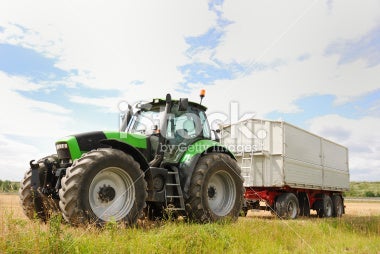
It's gotta have something to do with speed , because these types of trailers are ubiquitous on tractors and other slow farm equipment, but not out on the road.
 HammerheadFistpunch
> If only EssExTee could be so grossly incandescent
HammerheadFistpunch
> If only EssExTee could be so grossly incandescent
07/23/2014 at 14:27 |
|
ideal for load carrying, I imagine they are death on wheels at any kind of speed.
 You can tell a Finn but you can't tell him much
> If only EssExTee could be so grossly incandescent
You can tell a Finn but you can't tell him much
> If only EssExTee could be so grossly incandescent
07/23/2014 at 14:43 |
|
What Hammerhead says. Ever see one going down the road behind a tractor? They sway all over the place.
 uofime
> TJDMAX
uofime
> TJDMAX
07/23/2014 at 15:00 |
|
I would agree with the slower except good luck getting them to obey that limitation!
in truth it's probably just as unlikely to get them to tow less as well....
 You can tell a Finn but you can't tell him much
> HammerheadFistpunch
You can tell a Finn but you can't tell him much
> HammerheadFistpunch
07/23/2014 at 15:01 |
|
For your next act you need to explain the black magic that is a weight distributing hitch.
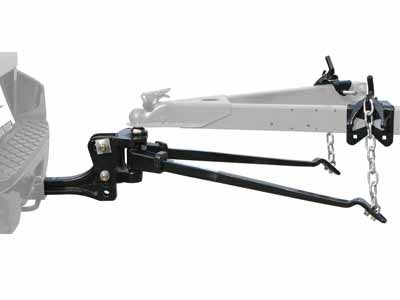
 uofime
> HammerheadFistpunch
uofime
> HammerheadFistpunch
07/23/2014 at 15:05 |
|
the only thing you need to keep in mind with boats is that they have a strong rearward weight bais which makes sense when you think about the engine for outboards literally hanging off the back
 HammerheadFistpunch
> uofime
HammerheadFistpunch
> uofime
07/23/2014 at 15:07 |
|
but most boat trailer have very rear oriented axles to compensate.
 TJDMAX
> uofime
TJDMAX
> uofime
07/23/2014 at 15:22 |
|
Except speed is more easily enforceable than weight. But yea...dumb people are gonna do dumb things..
 uofime
> HammerheadFistpunch
uofime
> HammerheadFistpunch
07/23/2014 at 15:24 |
|
correct, I'm just saying not to get to over confident that they have a great distribution
 uofime
> TJDMAX
uofime
> TJDMAX
07/23/2014 at 15:25 |
|
yup
 HammerheadFistpunch
> uofime
HammerheadFistpunch
> uofime
07/23/2014 at 15:26 |
|
I've been driving for over 16 years and pulling boats for 17 (yes, you read that right). All shapes and sizes, but usually 3-6k lb 21-26 foot boats with suv's and trucks. Nothing is as easy to pull as a boat with a good trailer. Nothing is as horrifying as a boat on a shit trailer.
 OzzyOnIce
> HammerheadFistpunch
OzzyOnIce
> HammerheadFistpunch
07/23/2014 at 15:40 |
|
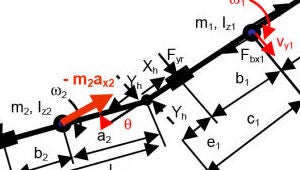
This is (a chart of) your brain on drugs
 HammerheadFistpunch
> uofime
HammerheadFistpunch
> uofime
07/23/2014 at 15:42 |
|
some countries require you to fit a limited to your vehicle when towing above a certain weight...
 HammerheadFistpunch
> TJDMAX
HammerheadFistpunch
> TJDMAX
07/23/2014 at 15:44 |
|
Awesome, thanks for this. So it does sound like there is a large safety margin still, BUT that the net effect is that the sum of the parts does not equal an overall high safety margin. Probably perfectly safe up to GVRW, GAWR and Tow ratings...and maybe a a little over, but not a lot.
 uofime
> HammerheadFistpunch
uofime
> HammerheadFistpunch
07/23/2014 at 15:51 |
|
I wonder how that works, I guess you could do it over OBD-II on newer stuff
 HammerheadFistpunch
> uofime
HammerheadFistpunch
> uofime
07/23/2014 at 15:52 |
|
yeah, im not sure. Some places require it, some recommend it. I imagine it ties into the can-bus somehow.
 uofime
> HammerheadFistpunch
uofime
> HammerheadFistpunch
07/23/2014 at 15:56 |
|
I too have experience towing boats and agree. You see some pretty funny shit on boat ramps
 HammerheadFistpunch
> uofime
HammerheadFistpunch
> uofime
07/23/2014 at 15:57 |
|
hanging around a boat ramp on the 4th of July or similar holiday is comedic gold.
 TJDMAX
> HammerheadFistpunch
TJDMAX
> HammerheadFistpunch
07/23/2014 at 16:02 |
|
Exactly. I mean those tow ratings start from somewhere anyways....OEM's don't just pull a number out their ass and assume that it'll be the rating. It all comes down to component choice. There is always some wiggle room in ratings, its just a gamble as to how much...best to just stick at or around ratings, unless you know what you're doing and or have upgraded components etc.
 uofime
> HammerheadFistpunch
uofime
> HammerheadFistpunch
07/23/2014 at 16:03 |
|
My favorite campsite on the lake I go to has a view of the boat ramp
 McLarry
> cabarne4
McLarry
> cabarne4
07/23/2014 at 16:13 |
|
"Towing 3,500 lbs with a Fozzy is no different in AUS vs USA" - that's crazy talk... you have to do it upside-down in AUS. Totally different.
 OzzyOnIce
> HammerheadFistpunch
OzzyOnIce
> HammerheadFistpunch
07/23/2014 at 16:13 |
|
"towing a trailer" and "Fast downhill roads" make me want a new race series:
DRIFT TOWING! it would put a demolition derby to shame :)
 VWhunter
> HammerheadFistpunch
VWhunter
> HammerheadFistpunch
07/23/2014 at 16:22 |
|
I use my 2007 Honda CR-V AWD to pull a car hauler trailer rescuing VW's in Arkansas
 StevenG
> HammerheadFistpunch
StevenG
> HammerheadFistpunch
07/23/2014 at 16:22 |
|
He said keep the speed down. For the record in some states the speed limit is 55mph.
 davedave1111
> HammerheadFistpunch
davedave1111
> HammerheadFistpunch
07/23/2014 at 16:23 |
|
That's a very long-winded way of saying that it's just protectionism for the US truck industry :)
 472CID
> HammerheadFistpunch
472CID
> HammerheadFistpunch
07/23/2014 at 16:23 |
|
Reading this reminds me about how I gave up on a mechanical engineering degree and got a bachelors in business.
 HammerheadFistpunch
> StevenG
HammerheadFistpunch
> StevenG
07/23/2014 at 16:24 |
|
keep reading this thread, we have come to an accord.
 HammerheadFistpunch
> davedave1111
HammerheadFistpunch
> davedave1111
07/23/2014 at 16:25 |
|
its a conspiracy!
 HammerheadFistpunch
> 472CID
HammerheadFistpunch
> 472CID
07/23/2014 at 16:26 |
|
Turns out my poor math comprehension might be due to Dyscalculia and had I known I might be even nerdier than I am now.
 Seraph99
> HammerheadFistpunch
Seraph99
> HammerheadFistpunch
07/23/2014 at 16:27 |
|
"It's pretty math heavy and I'm not sure I understand it completely but from It I gleaned a lot of information. Here goes:" There, that is the exact point where you lost me in this article.